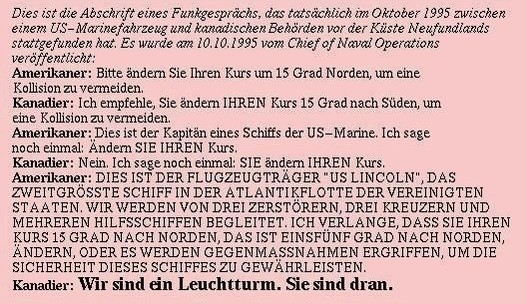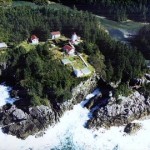This is based on an actual radio conversation between a U.S. Navy aircraft carrier (U.S.S. Abraham Lincoln) and Canadian authorities off the coast of Newfoundland in October, 1995. (The radio conversation was released by the Chief of Naval Operations on 10/10/95 authorized by the Freedom of Information Act.)
Canadians: Please divert your course 15 degrees to the South to avoid collision.
Americans: Recommend you divert your course 15 degrees to the North to avoid a collision.
Canadians: Negative. You will have to divert your course 15 degrees to the South to avoid a collision.
Americans: This is the Captain of a US Navy ship. I say again,divert YOUR course.
Canadians: No, I say again, you divert YOUR course.
Americans: THIS IS THE AIRCRAFT CARRIER USS LINCOLN, THE SECOND LARGEST SHIP IN THE UNITED STATES’ ATLANTIC FLEET. WE ARE ACCOMPANIED BY THREE DESTROYERS, THREE CRUISERS AND NUMEROUS SUPPORT VESSELS. I DEMAND THAT YOU CHANGE YOUR COURSE 15 DEGREES NORTH–I SAY AGAIN, THAT’S ONE FIVE DEGREES NORTH–OR COUNTER-MEASURES WILL BE UNDERTAKEN TO ENSURE THE SAFETY OF THIS SHIP.
Canadians: This is a Canadian lighthouse. Your call.
– Author Unknown
Now this is quite funny, but what is even better is that it is not true and has been around from at least the 1960s according to some websites. Check out the US Navy website where they contradict the “facts”!
Click the screen below to see a video version of the same joke.
A funny video with a United States warship against a lighthouse, somewhere in the Irish Sea. . .
******************************
It looks like this joke has world-wide acclaim. Here’s a Scottish version . . .
In the middle of foggy night in the North-west Atlantic…..two lights are heading directly for one another… and on the radio an American voice is heard saying “We suggest you alter course by 10 degrees to port”.
Back comes the reply “We suggest YOU alter course by 10 degrees to port!”
Then the American voice says “This is the battleship USS Missouri leading the American Atlantic battle fleet. You had better alter course by 10 degrees to port.”
Back comes the reply “This is the Outer Hebrides lighthouse, but it’s your call, Jimmy”.
*******************************
and before the days of TV . . . … a 1939 book shows:
The fog was very thick, and the Chief Officer of the tramp steamer was peering over the side of the bridge. Suddenly, to his intense surprise, he saw a man leaning over a rail, only a few yards away.
“You confounded fool!” he roared. “Where the devil do you think your ship’s going? Don’t you know I’ve got the right of way?”
Out of the gloom came a sardonic voice: “This ain’t no blinkin’ ship, guv’nor. This ‘ere’s a light’ouse!”
*************************************
And not to be left out, here is a German language version:

While we are in the German section, might as well add this one too! 🙂

